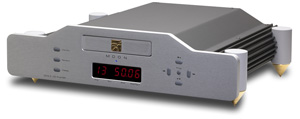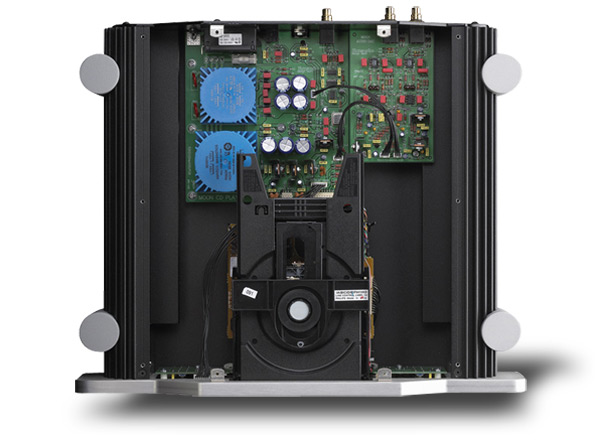![[SoundStage!]](../titles/sslogo3.gif) Home
Audio Home
Audio Equipment Review |
|||||||||||||||||||
March 2007 Simaudio Moon CD5.3 CD Playerby Philip Beaudette
"Three thousand dollars for a CD player?" That was the question I imagined was running through my friends' minds when I told them the price of the Simaudio Moon CD5.3. Most of them don't even own a standalone CD player. Instead they play music off the hard drives of their computers or from their iPods. Those who do listen to CDs usually do so with their DVD players, often inexpensive ones at that. I'm not here to criticize DVD players, which can sound superb, but I don't think the engineers who design mass-market DVD players are primarily concerned with sound quality. Features and video quality are their biggest priorities, and sound quality is often an afterthought. All of my music is stored on CD, so it's very important for me to have a high-quality player that can extract all of the detail and dynamic range that I know are present on my discs. Quality doesn't come cheap, and among the things I wanted to know was whether the CD5.3's performance justified its asking price. After all, nothing about sound is an afterthought to the folks at Simaudio. Lunar legacy Simaudio began building affordable high-quality audio products in 1980. In the 1990s, the company introduced the oval-faced Celeste series of power amps, preamps and integrated amps. These were followed in 1997 by the introduction of Simaudio's reference-grade Moon components, a series well received by consumers and critics alike. Two years ago Simaudio released the statement-level Moon Evolution series, and these products still reside at the top of the Moon hierarchy today. The CD5.3 is from Simaudio's Moon Classic series. It is the companion to the Moon i5.3 integrated amplifier that I reviewed last month, and cosmetically the two are similar. The CD5.3 measures 17"W x 5"H x 15"D and therefore occupies more shelf space than the integrated. This is due to the Philips L1210S transport mechanism, the same one used for Simaudio's Evolution SuperNova CD player, that sits atop the large alphanumeric display with its pinball-machine-inspired red digits. As with the i5.3, the CD5.3 has a thick front faceplate and heat sinks running down both sides, and it is housed in an overbuilt steel enclosure, helping it tip the scales at 27 pounds. For those keeping track, that's only a pound lighter than the i5.3, and a good thing, given that the purpose is to minimize the effect of external vibration. If you've never seen any product from the Moon Classic series, visit a hi-fi shop and inspect the components in person. If you're new to this area of the market, you'll be more than a little surprised by what you encounter. To see and lift the CD5.3 is to understand the nature of products at this price point. Excellent attention to detail, unique cosmetics and near bombproof build are their hallmarks. Given these attributes, $3000 won't seem unreasonable.
Unfortunately what you won't see at your local audio shop is what's under the hood. The CD5.3 employs separate toroidal transformers for the digital and analog sections. In conjunction with no less than eight stages of DC voltage regulation, these ensure a solid power supply. Digital and analog circuitry employ separate ground planes and are mounted on a single circuit board with pure copper tracings that feature very low-impedance characteristics. This helps to reduce the length of the signal path, thereby helping to eliminate any chance of signal degradation. Digital-to-analog converters are 1730E chips from well-known manufacturer Burr-Brown. The DACs feature 24-bit/192kHz resolution and employ an 8x oversampling. Furthermore, there is internal upsampling to 24-bit/352.8kHz data. On the right side of the thick aluminum faceplate you can find all of the basic controls necessary to play CDs. On the left side are buttons to play CD tracks in random order, put the player in standby mode and turn off the bright-red display. I rarely used these buttons, but if you need them you've got them. The unit's remote control is an all-aluminum full-function unit that, like the machine it's used to operate, is heavy and sturdily built. Although the remote seemed unnecessarily long, the inclusion of buttons for volume, input switching and channel balance meant I had no need for the i5.3's remote when using it and the CD5.3 together. Simsound In my review of the i5.3, I noted that what really caught my attention was its sparkling highs. This is also true of the CD5.3. Vibrant, engaging and dynamic are all apt words for describing its sound. Music leapt into the room, filling out not just the space in front of the speakers but behind them as well, and into the corners of the room. The sense of air around performers and instruments is what really set the CD5.3 apart. The soundstage was not only big, but everything in it was well separated. The open and revealing nature of the CD5.3's sound made musicians' locations easier to pick out. These are qualities I would expect when spending $3000 on a CD player, and the CD5.3 didn't disappoint. Although I could cite many discs where these characteristics were ably demonstrated, one I'll discuss is Loreena McKennitt's newest CD An Ancient Muse [Quinlan Road QRCD109]. Anyone familiar with McKennitt's discography will know that although her influences come from her travels abroad, her sound is firmly rooted in Celtic music. On Muse this is still readily apparent, but there's also a strong Middle Eastern influence that caught my attention enough to ensure the disc gets regular play. The musicians perform with a diverse array of instruments, and it was in producing these that the CD5.3 really shone. I couldn't always identify the instruments being played (can you tell the difference between the Celtic bouzouki and the Greek bouzouki?), but it wasn't important. The CD5.3 allowed the instruments to occupy their own space and spread them across a wide soundstage that was deeper than any I've heard in my room -- that grabbed my attention. Percussion had a touch of warmth and bloom that was musical, not sloppy. McKennitt's voice sounded open, and it filled the listening space as it projected into my room. Although there are several aspects of the CD5.3's sound I was drawn to, its openness was one of its most notable and impressive characteristics.
I've been listening to some of my Reference Recordings discs lately to hear how they capture huge dynamic shifts, bringing the extraordinary power of a symphony orchestra into my room in a mere instant. For someone like me, in the early stages of building a classical music collection, these recordings are excellent because they offer a "you are there" listening experience that I find lacking with too many other discs in my collection. "War Dance" from Respighi's Belkis, Queen of Sheba-Suite [Reference Recordings, RR-95CD] is a perfect CD to showcase the live sound that I find is characteristic of this record label -- and the CD5.3. The rhythm of the war drums increases throughout the dance until their rapid-fire assault beats so relentlessly that you'll find your heart is racing faster. The piece switches so quickly from one section of the Minnesota Orchestra to the next that it's hard to keep pace with what's happening. "War Dance" was just one example where the CD5.3's ability to easily sort out a musical passage and produce a wide and deep soundstage allowed me to hear further into the music and understand what was happening in front of me. This sort of involvement is what high-end audio is about, and the CD5.3 was fundamental in its occurrence. I mentioned that I connected the CD5.3 to four different integrated amplifiers. However, my favorite combination was easily the CD5.3 mated with the matching i5.3 integrated. Both pieces sound similar, and if you've read my review of the i5.3, you'll know this is a good thing. When I connected the CD5.3 to my NAD C372, the sound was still very pleasing, but the warmth in the C372's presentation caused some of the CD players' qualities to be glossed over. Overall, detail retrieval was still good, but the sound just wasn't as transparent as with the i5.3. Hence most of my listening was done with an all-Simaudio system, and it was a pleasure. David and Goliath This biblical reference seemed appropriate for the sort of comparison I made between my NAD C542 CD player ($500) and the CD5.3. The latter weighs three times more than the former and costs six times its price. In pretty much every conceivable way it's a giant relative to the C542. So is it unfair to compare them to each other? One might be inclined to think so, but I actually found the experiment very interesting. With "Would" from the Alice in Chains CD Unplugged [Sony Music B000002BM5], the CD5.3 made music come alive. The space between the performers was greater, everything sounding more open and easier to discern as a result. Music was natural and free of any sort of strain that might otherwise detract from the performance. In fact, going back to my listening notes, I realized that I made similar observations when I listened to the DAC onboard the Bryston B100 SST integrated amp. Such qualities are the realm of high-end components, and the CD5.3 definitely belongs in this category. On "Last Hour" from From a Basement on a Hill [Anti 86741], Elliot Smith's voice was warmer through the NAD CD player, so much so that I felt something was being obscured. Switching over to the CD5.3, I heard what I was missing. The CD5.3 made Smith's vocals more lucid and pure in comparison, almost like the CD player wasn't doing anything except letting the man's real voice shine through. The CD5.3 wasn't adding anything to the sound; on the contrary, it removed the fine curtain that lesser equipment places between the listener and the music, which simply sounded more real. On "Black Swan" from Thom Yorke's The Eraser [XL Recordings XLCD200], the C542 softened the edges of notes while maintaining plenty of bass for a listening experience that was still wholly satisfying. Switching to the CD5.3 produced greater clarity in the midrange, and Yorke's voice was better delineated against the instrumental backdrop. Deep bass towards the end of the track was also tighter and sounded a touch less congested. Price considerations aside, the CD5.3 is a far more accomplished CD player than my reference NAD C542. For someone like me, the CD5.3 is a product to aspire to and a true upgrade. Conclusion I've really enjoyed having the Simaudio Moon CD5.3 in my system. Since the CD5.3 has been in my system, my NAD C542 has seen very little use -- only as part of the duties for this review. Because CD5.3 offers higher resolution, it was a valuable tool for evaluating the performance of other components, and its open sound made listening to music all the more enjoyable. Ultimately, much of my reviewing was done with the CD5.3 mated to the matching i5.3 integrated, and the two performed brilliantly together -- an example of synergy if ever there was one. They spoke with the same clear voice. Sitting in a darkened room with their big displays staring back, I found that listening to these Simaudio components gave me great satisfaction. They are well-crafted, musically consonant products, and I have no reservations recommending them. In fact, I'm already starting to miss their big red digits. ...Philip Beaudette
|
|||||||||||||||||||
|
|||||||||||||||||||
![[SoundStage!]](../titles/sslogo3.gif) All
Contents All
ContentsCopyright © 2007 SoundStage! All Rights Reserved |

